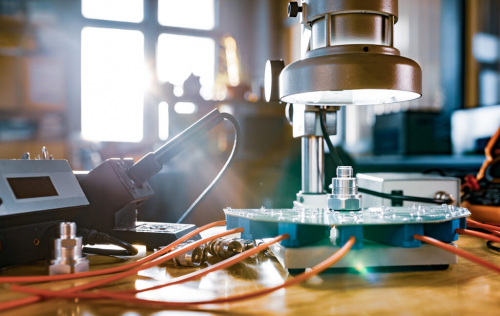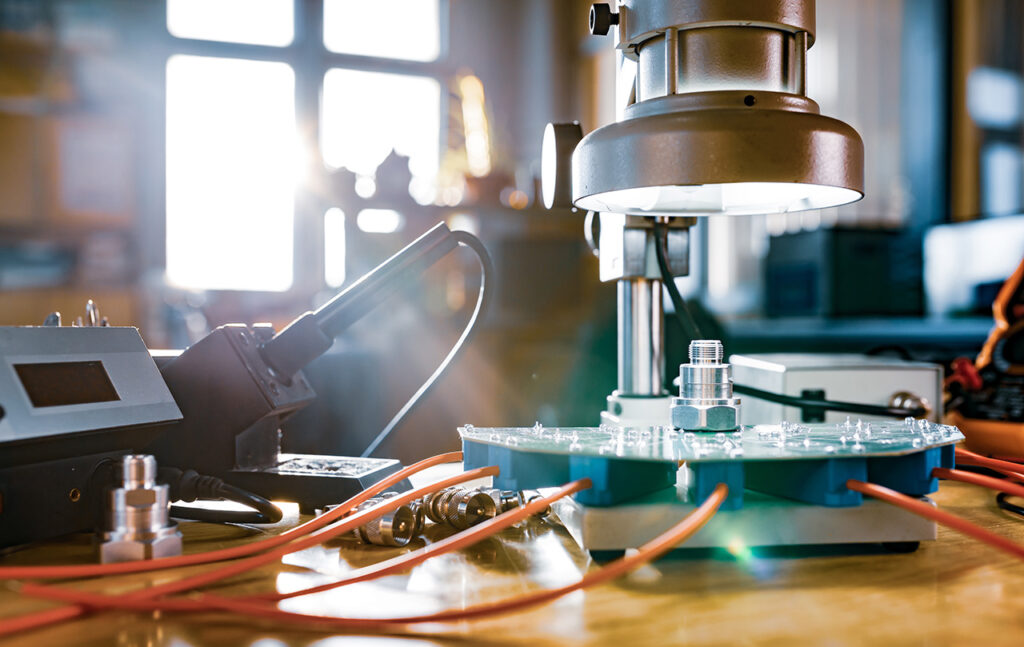As systems become more complex and integrate more functionality onto a circuit, semiconductor testing has become a particularly important area for connectors used in test and measurement. Test equipment measures the electrical or mechanical characteristics, performance, and behavior of a component or system. Connectors of all types are subjected to test procedures, and the test equipment itself may include the connector. The test procedure may be mechanical, such as insertion/extraction force, retention force, axial and lateral bend, or cable pull. It may also be electrical, including contact or insulation resistance, current cycling, insertion loss, or shielding effectiveness.
Test and measurement plays a vital role in all stages of the product lifecycle, from R&D to manufacturing, deployment and maintenance. It ensures that products meet quality standards, regulatory requirements and customer expectations. In addition, it promotes continuous improvement, optimization and innovation by providing valuable feedback and insights for design and performance enhancements.

1. Connectors used in test and measurement equipment
Test and measurement uses a variety of interconnects to establish reliable connections with different devices and components. The specific connector employed may vary depending on the instrument type, intended use, and the electrical and mechanical characteristics required. Common cable and connector types used in test and measurement equipment include:
- BNC (Neill-Concelman Bayonet): BNC connectors are widely used in test and measurement equipment, especially in applications involving RF (radio frequency) signals. They provide a secure connection and are easy to connect and disconnect.
- SMA (Subminiature Version A): SMA connectors are typically used in high-frequency applications. They have excellent performance at microwave frequencies and are often used in RF and microwave test equipment.
- Type N: Type N connectors are larger and perform well at higher frequencies. They are often used in RF applications such as antenna connections and high-power measurement equipment.
- TNC (Threaded Neill-Concel man ): TNC connectors are similar to BNC connectors, but have a threaded interface. They provide a more secure connection and are often used in applications that require greater mechanical stability.
- SMB (Subminiature Version B): SMB connectors are compact push-on connectors designed for applications requiring reliable connections up to several GHz. They are often used in test and measurement equipment, especially instrumentation and communications equipment.
- SMC (Subminiature Version C): SMC connectors are smaller than SMB connectors and offer a higher frequency range, typically up to 10GHz. They are often used in test and measurement equipment and other electronic devices.
- USB (Universal Serial Bus): USB connectors are widely used in test and measurement equipment for data transfer and device control. They provide a standardized interface for connecting a variety of devices, such as oscilloscopes, data loggers, and multimeters.
- Ethernet (RJ-45): Ethernet connectors usually adopt RJ-45 interface and are used for network connection of test and measurement equipment with networking function. They support communication and data transmission between instruments and computer networks.
- GPIB (General Purpose Interface Bus): GPIB connectors, also known as IEEE488 connectors, are used on older test and measurement equipment to establish connections based on the GPIB standard. They were commonly used in the past for instrument control and data transfer, but have been largely replaced by other interfaces.
- Test Socket: A test socket is an electromechanical interface that provides an extremely clean electrical signal path. Test sockets are used to test high frequency ICs without soldering them to a PCB.
- Banana Plugs and Jacks: Banana plugs and jacks are commonly used in low-frequency applications to connect various types of test leads, such as those used with multimeters and power supplies.
- Micro Coaxial Cable: Micro coaxial cable is a flexible coaxial cable that has a smaller outer diameter than traditional coaxial cable (1 mm or less), so it takes up less space in test applications. These cables are often mated with micro coaxial connectors.
- Test Probe: Electrical test probes make a connection between the circuit under test and the measuring instrument.
2. Test Type
Common tests performed in test and measurement include:
- Electrical testing: This includes tests that measure electrical parameters like voltage, current, resistance, capacitance, inductance, and frequency. Instruments like multimeters, oscilloscopes, and signal generators are used for electrical testing.
- Signal Analysis: Test and measurement equipment is used to analyze signals and waveforms. This involves tests such as spectrum analysis, frequency analysis, distortion analysis, and modulation analysis. Spectrum analyzers, network analyzers, and audio analyzers are commonly used for signal analysis.
- Functional Testing: Functional testing verifies the functionality and performance of an electronic device or component. It involves applying a stimulus and measuring the corresponding response to ensure proper operation. This can be done using a variety of instruments such as function generators, logic analyzers, and protocol analyzers.
- RF and Microwave Testing: RF and microwave testing involves measurements and tests performed at high frequencies. This includes tests such as power measurement, impedance matching, network analysis, and antenna testing. Instruments such as RF power meters, vector network analyzers, and spectrum analyzers are used for RF and microwave testing.
- Environmental testing: Test and measurement equipment is used to evaluate the performance and reliability of a device under different environmental conditions. This may involve temperature, humidity, vibration, shock, and electromagnetic interference (EMI) testing. Environmental chambers, vibration testers, and EMI receivers are used for environmental testing.
- Protocol Testing: Protocol testing involves analyzing and verifying the communication protocols used in various devices and systems. It ensures compatibility, reliability, and adherence to standard protocols. Protocol testing uses instruments such as protocol analyzers and logic analyzers.
- Destructive/Non-destructive testing: Testing a product, component, or material by deformation or destruction to analyze its failure point. Non-destructive testing uses inspection methods that do not damage the material or asset in any way.
- Power Quality Analysis: Power quality testing involves evaluating the quality and stability of the power system. It includes voltage fluctuations, harmonics, power factor, and energy consumption testing. Power analyzers and power quality analyzers are used for power quality analysis.
- Safety testing: Safety testing ensures that electrical equipment and devices comply with specified safety standards and regulations. It includes insulation resistance, ground resistance, leakage current, and electrical safety testing. Insulation testers and safety analyzers are often used for safety testing.
3. Testing Process
The test and measurement process typically takes the following steps:
- Test plan: Defines the objectives, requirements, and test parameters based on the specific needs of the product or system being tested.
- Test setup: Configuring the test environment, connecting the appropriate instruments, and preparing the device under test (DUT) for measurement.
- Test execution: Applying controlled conditions, stimuli, or inputs to the DUT and measuring its response. This may involve instruments such as oscilloscopes, multimeters, spectrum analyzers, or network analyzers.
- Data Analysis: Process and analyze the collected data to gain insights, identify patterns, inconsistencies or trouble spots, and understand the performance and characteristics of the DUT.
- Reporting and Documentation: Recording of test results including measurements, observations, analysis, and questions or recommendations required for quality control, compliance, and future reference.
4. Markets, sectors and applications
Automotive, Datacom/Telecom, Test & Measurement, Medical, Military & Aerospace, Consumer Electronics, etc.
Every industry requires industry-specific testing and the use of tested components. Standards bodies and safety and regulatory compliance organizations conduct rigorous testing to ensure that products meet their specific safety and performance guidelines. Testing and measurement plays a key role in regulatory, certification and standards bodies, including UL, CE, DIN, IEC, RoHS, REACH, IEEE, IP and ISO. KONNRA connectors have a good reputation in the industry and have obtained multiple certifications such as ISO9001, ISO14001, ISO13485, IPC620, IATF16949, UL, etc., ensuring that the products meet strict standards in quality and environmental protection. Through these certifications, KONNRA continuously optimizes the production process to improve the reliability and stability of its products, and strives to provide customers with high-quality services and solutions.










